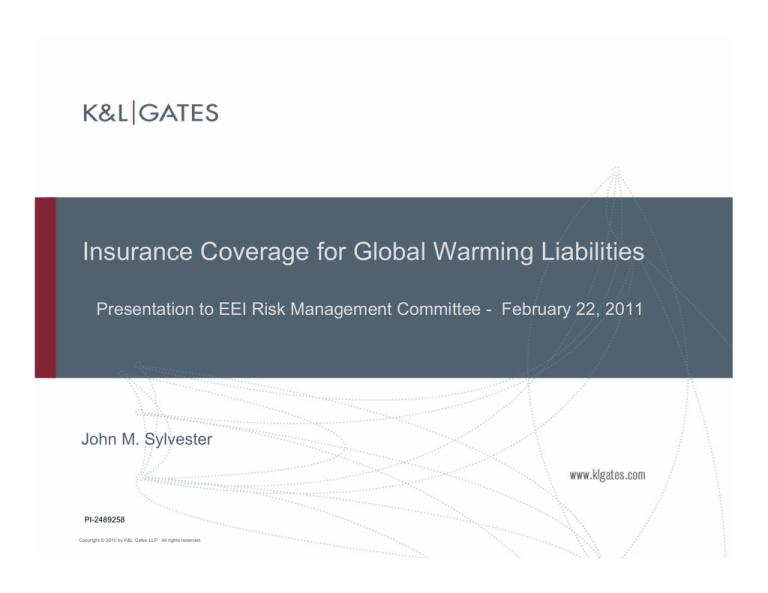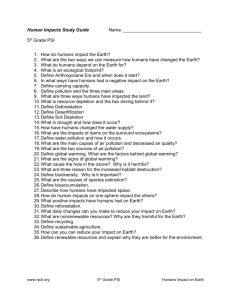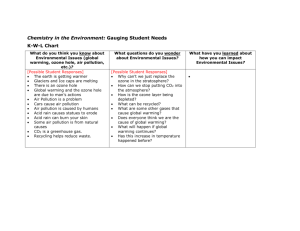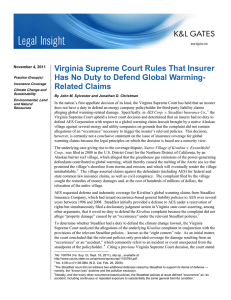
Insurance Coverage for Global Warming Liabilities
Presentation to EEI Risk Management Committee - February 22, 2011
John M. Sylvester
PI-2489258
Copyright © 2010 by K&L Gates LLP. All rights reserved.
I.
Global Warming Claims
“The harms associated with climate change are serious and well
recognized” and the “EPA does not dispute the existence of a
causal connection between man-made greenhouse gas
emissions and global warming.” Massachusetts v. Envtl. Prot.
Agency, 549 U.S. 497, 521, 523 (2007)
Swiss Re: “[w]e expect … that climate change-related liability
will develop more quickly than asbestos-related claims and
believe the frequency and sustainability of climate changerelated litigation could become a significant issue within the next
couple of years.” See Urs Leimbacher, et al., The Globalisation
of Collective Redress: Consequences for the Insurance
Industry, Swiss Re, at 3 (2009), http://www.swissre.com.
Three lawsuits known to date that have sought damages
caused by global warming from industrial companies’
greenhouse gas emissions which allegedly contributed to such
global warming.
Are these lawsuits the tip of the iceberg or last of their kind?
1
I.
Global Warming Claims
A. Connecticut v. American Electric Power Co., Inc.,
Docket Nos. 05-5104-cv, 05-5119-cv (S.D.N.Y. 2005)
8 states, New York City, Land Trusts brought suit against
six power companies
Sought injunctive relief against future emissions
Dismissed in 2005 – nonjusticiable issue
Second Circuit reversed on September 21, 2009
En banc rehearing denied March 5, 2010
Petition for certiorari granted by U.S. Supreme Court on
December 6, 2010
Argument date before Supreme Court pending
2
I.
Global Warming Claims
B. Comer v. Murphy Oil USA, Case No. 1:05-cv-00436LTS-RHW (S.D. Miss. Aug. 30, 2007)
Mississippi Gulf Coast residents allegedly damaged by
Hurricane Katrina brought suit against numerous energy
and industrial companies
Lawsuit alleged global warming contributed to increase in
strength of Hurricane Katrina
Dismissed by district court
Fifth Circuit panel reinstates nuisance, trespass, and
negligence claims on October 16, 2009
En banc hearing granted, but further recusal issues
prevented quorum and appeal dismissed
Writ of mandamus to U.S. Supreme Court denied on
January 10, 2011.
3
I.
Global Warming Claims
C. Native Village of Kivalina v. ExxonMobil Corp., Civ.
Action No. CV 08 1138 (N.D. Cal. 2009)
Lawsuit alleges that global warming has led to erosion of
island village and damages to relocate are “hundreds
of millions of dollars”
Dismissed by district court on political question grounds
Plaintiffs appealed to Ninth Circuit
Briefs have been submitted and await decision by
Ninth Circuit
Is the Ninth Circuit waiting for AEP decision from
Supreme Court?
4
I.
Global Warming Claims
Steadfast v. AES
Only reported case involving liability insurance
coverage for any of the global warming claims
Held that the Kivalina claim did not constitute an
“occurrence” under the Steadfast policies at issue
AES appealed to Virginia Supreme Court
Briefing is closed as of October 2010
No hearing date set yet, but expected in
coming months
5
II.
A.
B.
C.
D.
E.
F.
G.
General Liability Coverage – Key Issues
Duty to Defend
Fortuity Issues
Property Damage/Bodily Injury
“As Damages”
Trigger/Scope
Pollution Exclusion
Notice
6
A.
Duty to Defend
An insurer’s duty to defend is broader than its
duty to indemnify.
The duty to defend is triggered by the tender of a
claim that is potentially covered under the policy,
which is determined, at the outset, by the
allegations of the complaint.
The global warming claims have only involved
defense costs to date.
If viable, these claims will involve a substantial
discovery and litigation process due to the
complex causation and proof issues.
7
B.
Fortuity Issues
Insurers’ argument - damage caused by a
policyholder’s GHG emissions is not “fortuitous”
because companies have long known they were
emitting GHGs
Specific Policy Defenses
No “accident”/“occurrence” - deliberate actions
Damage was “expected or intended”
Known loss/loss in progress at time of
underwriting
8
B.
Fortuity Issues
Policyholder’s responses
No Occurrence/Expected or Intended
Most jurisdictions require that the resulting damage be
expected and intended by the policyholder
Specific damage v. any damage expected or intended
Subjective v. objective standard
Known Loss
If applicable, known Loss is a first-party concept
“Loss” covered by GL policy is the legal obligation to pay
damages
Issue is whether the policyholder was aware of the legal
liability at the inception of the policy
9
B.
Fortuity Issues
Steadfast v. AES Decision
Steadfast raised three primary defenses:
No occurrence
Loss in progress
Pollution exclusion
Trial Court decided only on “occurrence” issue and
did not reach other two defenses
Impact of Steadfast unclear
No written opinion
AES has appealed to VA Supreme Court
10
Steadfast v. AES Decision
Steadfast argued Virginia law does not require
proof that policyholder intended damage.
Court based decision on VA’s “8-corners” rule –
court looks to 4 corners of complaint to see if
allegations, if proven, would provide a basis for
coverage under 4 corners of policy
Kivalina complaint arguably provides basis for
liability in negligence or at least raises issues of
fact on policyholder’s intent
11
Steadfast v. AES Decision
Decision arguably limited to AES
Complaint alleged facts about statements in AES’ annual
reports regarding GHG emissions
Allegations against other companies do not refer to
annual reports
Steadfast limited to Kivalina Claim
AEP nuisance claims based on allegations that
defendants negligently or intentionally created and
contributed to global warming
Comer contains negligence count. Neither trespass nor
nuisance claims allege defendants intentionally caused
damage
12
C.
Property Damage/Bodily Injury
“Property damage” - “physical injury to tangible property, including
all resulting loss of use of that property.”
“Bodily injury” - “bodily injury, sickness or disease sustained by a
person, including death resulting from any of these at any time.”
Kivalina Complaint, ¶¶ 3-4: “Global warming is destroying Kivalina
through the melting of Arctic sea ice that formerly protected the village
from winter storms …. The result of the increased storm damage is a
massive erosion problem. Houses and buildings are in imminent
danger of falling into the sea as the village is battered by storms and
its ground crumbles from underneath it.”
13
C.
Property Damage/Bodily Injury
Comer Complaint, ¶ 30: “The Defendants’ GHG emissions have
contributed to sea level rise, which has a number of severe
consequences including, but not limited to the following: (a) Direct loss
of private property as land is subsumed under rising sea levels and
destroyed by saltwater intrusion; (b) Loss of use and quiet enjoyment
of private property caused by rising sea levels, saltwater intrusion,
increased water temperatures, increased tropical storm activity, loss of
habitat used for hunting and fishing and other recreation, and
numerous other forms of property damage; (c) Loss of the use and
enjoyment of public property caused by the subsumption and erosion
of public beaches; (d) Loss of the use and enjoyment of public trust
resources caused by subsumption of and saltwater intrusion into
habitat for fish and wildlife …; and (e) Increased risk of property
damage and loss as a result of hurricane activity in the Gulf of Mexico.”
14
D.
“As Damages”
Most standard general liability policies cover sums
that the policyholder is “legally obligated to pay as
damages” because of property damage or bodily
injury
Insurers argue that the phrase limits their coverage
obligations to only compensatory relief sought by an
underlying plaintiff
Comer and Kivalina, which seek monetary damages
for property damage or bodily injury, appear to meet
this definition
What about injunctive relief as sought in cases like
American Electric Power?
15
D.
“As Damages”
In environmental claims context, the majority of
courts have rejected the insurers’ narrow reading of
“as damages” and have found that governmentmandated environmental remediation costs are
“damages” under a general liability policy
But see Cinergy Corp. v. Associated Elec. & Gas
Ins. Servs., Ltd., 865 N.E.2d 571, 581-83 (Ind.
2007) (distinguishing between remediation costs
and prophylactic measures under Clean Air Act
claims).
16
E.
Trigger/Scope
Claims-made policies – triggered by claim made during policy
period.
Occurrence-based policies - some part of the alleged property
damage or bodily injury takes place during the policy period,
regardless of when the claim is asserted
Two main issues will impact a policyholder’s ability to access
historical insurance coverage: (1) the allegations of the
underlying complaint; and (2) the governing jurisdiction’s law
regarding trigger of coverage.
There is a reasonable argument that historical occurrencebased policies are triggered by these current claims because
the alleged damage caused by GHG emissions has been
ongoing for decades
If multiple policy years are triggered, jurisdictions differ
regarding the scope of each policy year’s coverage
responsibility
17
F.
Pollution Exclusion
1.
History of Pollution Exclusion in Liability Policies
No pollution exclusions prior to 1970
Qualified (sudden and accidental) pollution exclusion
between 1970 and 1985
Absolute pollution exclusion after 1985
18
F.
Pollution Exclusion
2. Are GHG “Pollutants”?
Policy language controls whether GHGs constitute “pollutants”
under a pollution exclusion
“Pollutants” typically defined as “any solid, liquid, gaseous or
thermal irritant or contaminant, including smoke, vapor, soot,
fumes, acids, alkalis, chemicals and waste.”
No cases have ruled directly on whether GHG are “pollutants”
under a CGL policy exclusion
Carbon dioxide – which is typically the most prevalent of the
regulated GHGs emitted –not traditionally considered as an
irritant, contaminant, or pollutant.
However, Massachusetts v. EPA decision held that emitted
carbon dioxide was a pollutant under the Clean Air Act
Steadfast also argued that Kivalina Complaint characterizes
GHG’s as pollutants or pollution
19
F.
Pollution Exclusion
Massachusetts v. EPA
Focus was EPA’s regulation of GHGs, not pollution
exclusion
Policies define “pollutant” more narrowly than does
the Clean Air Act.
CAA’s sweeping definition includes ‘any air pollution agent
or combination of such agents, including any physical,
chemical … substance or matter which is emitted into or
otherwise enters the ambient air ….’
“On its face, the definition embraces all airborne
compounds of whatever stripe…”
Scalia dissent: “it follows [from the majority opinion’s
holding] that everything airborne, from Frisbees to
flatulence, qualifies as an ‘air pollutant.
Cases in other contexts have held carbon dioxide is
not a “pollutant”
20
F.
Pollution Exclusion
3. Ambiguity Issues
Most courts addressing the application of the
pollution exclusion to carbon dioxide or other similar
gases have held that the pollution exclusion is
ambiguous
Ambiguous language is given an interpretation most
favorable to the insured.
Exclusions in polices are to be construed strictly
against the insurer.
Reasonable expectations of insured as to coverage
21
G.
Notice
Many policies require notice of claims or occurrences
as soon as practicable
Policyholders should provide notice and seek
coverage under every policy that possibly may be
triggered by the factual allegations of the given
lawsuit:
policy periods of the alleged injury or damage (historical
policies)
policy period in which claim was made
amount of potential damages sought (e.g., excess coverage)
Failure to provide timely notice provides insurers with
another defense
Insurer responses
Reservation of Rights
Denials of Coverage
22
G.
Notice
Insurers seem more aggressive in denying global
warming claims
Denial of coverage arguably starts limitations period
for insurance claim, which can very widely from
state to state
Mississippi & North Carolina– 3 years
Pennsylvania – 4 years
New Jersey & New York – 6 years
Indiana – 10 years
Ohio – 15 years
Tolling Agreements can toll running of limitations periods
23
Recommendations For Policyholders
Analyze all historical and recent liability polices for
potential coverage for global warming claims
Place all potential liability insurers on notice
Carefully analyze insurers’ responses for denials of
coverage
If an insurer has denied coverage, take action to avoid
running of the statute of limitations
24








